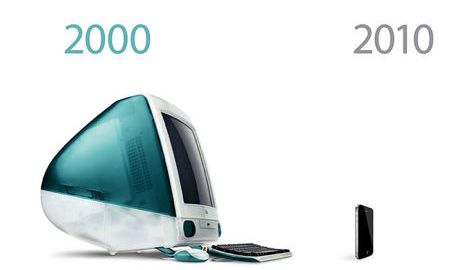Moore’s Law – Key to Understanding the Techonomy

Since our last post was about education, we decided to talk about Moore’s Law today, a trend we all need to be aware of in order to grasp how rapidly the power of technology and thus innovation is increasing.
They say a picture is worth a thousand words, so let’s start with the one that photographer Brett Moore recently put up on Flickr, which has been making the rounds on the Internet. The picture shows two familiar Apple products side-by-side: a vintage aqua bubble-shaped desktop iMac circa 2000 and this year’s sleek black panther iPhone. Below each product is a list of their capabilities, which on close inspection are incredibly revealing: First, the iPhone is much smaller than the iMac – over 100 times lighter in weight; second, despite the difference in size, the iPhone has double the processing power of the iMac; and third, the iPhone is three times cheaper.

The fact that technological power comes in smaller, faster and cheaper objects is a very important observation. In fact, it underlies many of the phenomena you see around you today such as higher resolution digital cameras in phones and cheaper sequencing and analysis of DNA. It also gives you a glimpse of the future – a world of tiny machinettes that will be your household companions, and a net of sensors that will coat your home making your life simultaneously more convenient and more public.
This trend was first observed by Gordon Moore in 1965 and he later projected that the doubling in processing power occurs every 24 months, i.e. it exponentially increases. Why is this the case? Processing power or the instructions the computer can perform per second has risen because more transistors can be fit per silicon wafer and because the multiple core processor micro-architecture has improved (layman’s lingo: more can be done with less – less space and less materials for the same power also means less cost).
There will come a time (some say in 10 years) when we won’t be able to fit more transistors onto a single chip. At that point, the only way Moore’s law can continue is if we switch from improvements in scale to improvements in structure and materials. Quantum computing holds some initial promise as a model that can not only continue, but increase the rate of Moore’s Law. Regardless, at least for the next decade, we can expect technology to pervade our lives in leaps and bounds, becoming ever more powerful even as it becomes ever more invisible. Think about that as you plan your career and your investments.
Ayesha and Parag Khanna explore human-technology co-evolution and its implications for society, business and politics at The Hybrid Reality Institute.





